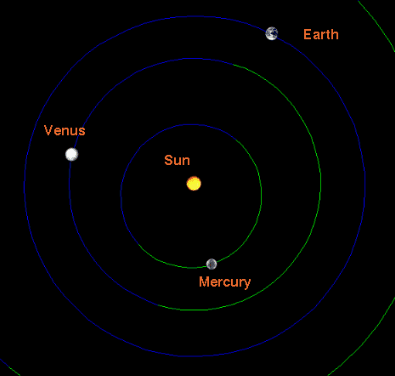General Features
of Mercury
 Mercury, the innermost planet, is 0.4 A.U. from the Sun on the average. It
revolves about the Sun once every 88 days in an orbit
that is the most elliptical of any planet except Pluto.
The adjacent image shows
the November, 1996, locations of the planets
in the inner solar system and their orbits.
(The image is constructed with
Solar System Live; it is
to scale for the orbits; the images of the planets
are not to scale since they would be tiny dots at this magnification.)
Mercury, the innermost planet, is 0.4 A.U. from the Sun on the average. It
revolves about the Sun once every 88 days in an orbit
that is the most elliptical of any planet except Pluto.
The adjacent image shows
the November, 1996, locations of the planets
in the inner solar system and their orbits.
(The image is constructed with
Solar System Live; it is
to scale for the orbits; the images of the planets
are not to scale since they would be tiny dots at this magnification.)
The orbits of Venus and Earth
appear to be circles on this scale, but the orbit of Mercury is clearly not
circular. As a result of its highly elliptical path the distance between
Mercury and the Sun varies a large amount, from 46 million kilometers at
perihelion to 70 million kilometers at aphelion.
Its mass is 5.5% of the Earth's mass, which is 5 times the mass of the Moon
(the best determination of the mass came from detailed tracking of the
spacecraft Mariner 10). The density is 5.5 g/cc, the same as Earth, and it has
a magnetic field that is about 1% of the strength of Earth's field. These facts
suggest a differentiated interior with a large iron core, with the weakness of
the magnetic field related in some way to the slow rotational period relative
to the Earth.
Its rotational period is 59 days, as determined by
radar measurements from the Earth using the
Doppler effect.
The ratio of the rotational period to the
orbital period is 2/3, and is an example of more complicated tidal locking than
for the Earth-Moon system. The tidal interaction between the Sun and Mercury
leads to a 2/3 ratio (instead of 1/1 as for our Moon) because the orbit of the
Moon about the Earth is almost a circle, but the orbit of Mercury around the
Sun is rather elliptical.
The surface conditions are among the harshest in the Solar System. During
the long Mercurian day the temperature rises to about 425 degrees Celsius, hot enough
to melt lead and
hotter than any planet except Venus. Because there is no substantial atmosphere
to retain heat, during the equally long nights,
the temperature drops quickly
to around -180 degrees Celsius, which is among the coldest found
in the Solar System. This range of -180 Celsius at night to 425 Celsius
in the day
is the largest surface temperature variation in the Solar
System.
 Mercury, the innermost planet, is 0.4 A.U. from the Sun on the average. It
revolves about the Sun once every 88 days in an orbit
that is the most elliptical of any planet except Pluto.
The adjacent image shows
the November, 1996, locations of the planets
in the inner solar system and their orbits.
(The image is constructed with
Solar System Live; it is
to scale for the orbits; the images of the planets
are not to scale since they would be tiny dots at this magnification.)
Mercury, the innermost planet, is 0.4 A.U. from the Sun on the average. It
revolves about the Sun once every 88 days in an orbit
that is the most elliptical of any planet except Pluto.
The adjacent image shows
the November, 1996, locations of the planets
in the inner solar system and their orbits.
(The image is constructed with
Solar System Live; it is
to scale for the orbits; the images of the planets
are not to scale since they would be tiny dots at this magnification.)